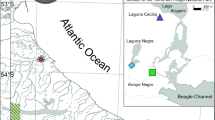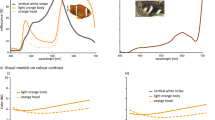Abstract
The visual acuity, visual axis and visual accommodation of pointhead flounder, slime flounder, and red halibut were determined to obtain basic knowledge for developing appropriate fishing gear and fishing methods for sustainable fisheries. Each of these species has a different ecotype in terms of habitat, depth and prey species. Thus, it was hypothesized that they may differ in terms of visual acuity, visual axis and visual accommodation. Few studies have compared these characters in flatfishes from different ecotypes. We used histological methods to determine visual acuity (i.e. cone cell density) and visual axis (i.e. cone cell distribution) in each of these species. The maximum visual acuity was 0.127 in pointhead flounder (total length, TL 344 mm), 0.092 in slime flounder (TL 372 mm) and 0.109 in red halibut (TL 336 mm). Based on the cone cell distribution in the retina, the visual axis was upward and forward in pointhead flounder, forward and downward in slime flounder, and downward in red halibut. Finally, the mean angle of lens movement was −2° in pointhead flounder, −13° in slime flounder and −32° in red halibut. This measurement of lens movement indicated that the average near-point distance was 0.87× TL in pointhead flounder, 0.65 × TL in slime flounder and 1.02 × TL in red halibut. At similar TL (336–355 mm), the visual acuity of these species differs depending on the direction in which they are looking.
Similar content being viewed by others
References
Watanabe T. The fisheries research of important fish — pointhead flounder. Bull. Jpn. Sea Reg. Fish. Res. Lab. 1956; 4: 249–269 (in Japanese).
Mikawa M. Studies on the digestive system and feeding habit of bottom fishes in the North-Eastern Sea area along the Pacific coast of Japan. Bull. Tohoku Reg. Fish. Res. Lab. 1953; 26: 26–36.
Yagishita N, Yamasaki A, Tanaka E. Age and growth of flathead flounder Hippoglossoides dubius collected off Kyoto Prefecture, Japan. Nippon Suisan Gakkaishi 2006; 72: 651–658.
Kitagawa D, Katayama S, Fujiwara K. Distribution and growth of flathead flounder Hippoglossoides dubius, off Tohoku area. Bull. Jpn. Soc. Fish. Oceanogr. 2004; 68: 151–157.
Watanabe T. The fisheries research of important fish — red halibut. Bull. Jpn. Sea Reg. Fish. Res. Lab. 1956; 4: 281–292 (in Japanese).
Omori M. A study on the production ecology of demersal fishes in Sendai Bay. 2. Interspecific relationships concerning habitat and food. Nippon Suisan Gakkaishi 1975; 41: 615–629.
Fisheries Agency. Annual Report on the Developments in the Fisheries in FY2006. Association of Agriculture and Forestry Statistics, Norin Tokei Kyokai. 2006; 54–62.
Wakayama K, Fujimori Y, Itaya K, Murakami O, Miura T. Mesh selectivity of gillnet for pointhead flounder Cleisthenes pinetorum. Nippon Suisan Gakkaishi 2006; 72: 174–181.
Ishito Y. The characteristics of distribution and migratory pattern of the slime flounder, Microstomus achne, adjusted by the life of their young and adult stages in the North-Eastern Sea area of Japan. Tohoku J. Agric. Res. 1972; 32: 23–46.
Blaxter JHS, Parrish BB, Dickson W. The Importance of Vision in the Reaction of Fish to Driftnets and Trawls. Modern Fishing Gear Of The World No. 2. Fishing News Books Ltd., London. 1964; 529–536.
Wardle CS. Fish reaction to towed fishing gears. In: Macdonald AG, Priede IG (eds). Experimental Biology at Sea. Academic Press, London. 1983; 168–195.
Olla BL, Davis MW, Rose C. Differences in orientation and swimming of walleye pollock Theragra chalcogramma in a trawl net under light and dark conditions: concordance between field and laboratory observations. Fish. Res. 2000; 44: 261–266.
Walls GL. The Vertebrate Eye and its Adaptive Radiation, reprinted 1963. Hafner, New York, NY. 1942; 785.
O’Connell CP. The structure of the eye of Sardinops caerulea, Engraulis mordax, and four other pelagic marine teleosts. J. Morphol. 1963; 113: 287–329.
Tsuruta Y, Omori M. Morphological characters of the oral organs of several flatfish species and their feeding behavior. Tohoku. J. Agric. Res. 1976; 27: 92–114.
Tamura T. A study of visual perception in fish, especially on resolving power and accommodation. Nippon Suisan Gakkaishi 1957; 22: 536–557.
Miyagi M, Akiyama S, Arimoto T. The development of visual acuity in yellowtail Seriola quinqueradiata. Nippon Suisan Gakkaishi 2001; 67: 455–459.
Somiya H, Tamura T. Studies on visual accommodation in fishes. Jpn. J. Ichthyol. 1973; 20: 193–206.
Kimura K, Tamura T. On the direction of lens movement in visual accommodation of teleostean eyes. Nippon Suisan Gakkaishi 1966; 32: 112–116.
Hibbard E. Grid patterns in the retinal organization of the cichlid fish Astronotus ocellatus. Exp. Eye Res. 1971; 12: 175–180.
Kawamura G, Nishimura W, Ueda S, Nishi T. Vision in tunas and marlins. Mem. Kagoshima Univ. Res. Ctr. S. Pac. 1981; 1: 3–47.
Engstrom K, Ahlbert IB. Cone types and arrangement in the retina of some flatfishes. Acta Zool. 1963; 9: 1–11.
Lythgoe JN. The Ecology of Vision. Oxford University Press, Oxford. 1979.
Thanapatay D, Fukurotani K. Relative spectral sensitivity and response delay time of S-potential in the retina of the Japanese flounder. Nippon Suisan Gakkaishi 2003; 69: 763–769.
Torisawa S. Visual acuity and spectral sensitivity of Sebastes schlegeli, Pleuronectes, yokohamae and Pleurogrammus azonus. PhD Thesis. University of Hokkaido, Hokkaido. 2002 (in Japanese).
Helvik JV, Drivenes O, Naess TH, Fjose A, Seo HC. Molecular cloning and characterization of five opsin genes from the marine flatfish Atlantic halibut (Hippoglossus hippoglossus). Vis. Neurosci. 2001; 18: 767–780.
Kawamura G, Tamura T. Morphological studies on the retina of two teleosts, Scomber tapeinocephalus and Halichoeres poecilopterus. Nippon Suisan Gakkaishi 1973; 39: 715–726.
Collin SP, Pettigrew JD. Retinal topography in reef teleosts. Brain Behav. Evol. 1988; 31: 269–282.
Tamura T, Wisby WJ. The visual sense of pelagic fishes, especially the visual axis and accommodation. Bull. Mar. Sci. Gulf Carib. 1963; 13: 433–448.
Momose O, Takei S, Maekawa Y, Uchida M, Somiya H. Visual accommodation system and retinal ganglion cell distribution in the retina of a dolphin fish. Nippon Suisan Gakkaishi 2003; 69: 933–939.
Collin SP, Pettigrew JD. Quantitative comparison of the limits on visual spatial resolution set by the ganglion cell layer in twelve species of reef teleosts. Brain Behav. Evol. 1989; 34: 184–192.
Shiobara Y, Arimoto T. Behavioral analysis of feeding experiments on the visual axis of red sea bream Pagrus major. Nippon Suisan Gakkaishi 1999; 65: 728–731.
Brunner G. Über die Sehschärfe der Elritze Phoxinus laevis bei verschiedenen Helligkeiten. Zeit. Vergl. Physiol. 1934; 21: 297–316.
Yamanouchi T. The visual acuity of the coral fish Microcanthus strigatus (Cuvier and Valenscienes). Pub. Seto Mar. Biol. Lab. 1956; 5: 133–156.
Nakamura EL. Visual acuity of two tunas, Katsuwonus pelamis and Euthynnus affinis. Copeia 1968; 1: 41–44.
Matsuda K, Torisawa S, Hiraishi T, Nashimoto K, Yamamoto K. Visual acuity and spectral sensitivity of the elkhorn sculpin Alcichthys alcicornis. Fish. Sci. 2005; 71: 1136–1142.
Scheuring L. Beobachtungen und Betrachtungen über die Beziehungen der Augen zum Nahrungserwerb bei Fischen. Zool. Jahrb. 1921; 38: 113–136.
Browman HI, Hawryshyn GW. Thyroxine induces a precocial loss of ultraviolet photosensitivity in rainbow trout (Oncorhynchus mykiss, Teleostei). Vision Res. 1992; 32: 2303–2312.
Browman HI, Hawryshyn GW. The developmental trajectory of ultraviolet photosensitivity in rainbow trout is altered by thyroxine. Vision Res. 1994; 34: 1397–1406.
Losey GS, Cronin TW, Goldsmith TH, Hyde D, Marshall NJ, McFarland WN. The UV visual world of fishes: a review. Journal of Fish Biology 1999; 54: 921–943.
Bublitz CG. Quantitative evaluation of flatfish behavior during capture by trawl gear. Fish. Res. 1996; 25: 293–304.
Fujita K, Kimoto K. Development of towed camera sledge systems to observe demersal juvenile fish. Bull. Natl. Res. Inst. Fish. Eng. 1999; 21: 41–46.
Evans S, Tallmark B. A modified drop-net method for sampling mobile epifauna on marine shallow sandy bottoms. Ecography 1979; 2: 58–64.
Suzuki K. The distribution of likelihood in the extension model of removal method. Math. Phys. Fish. Sci. 2003; 1: 127–139 (in Japanese).
Furuta S, Watanabe T, Yamada H, Nishida T, Miyanaga T. Changes in distribution, growth and abundance of hatchery-reared Japanese flounder Paralichthys olivaceus released in the coastal area of Tottori Prefecture. Nippon Suisan Gakkaishi 1997; 63: 877–885.
Shiobara Y, Arimoto T. Change in visual acuity and retinal adaptation according to light intensity for red sea bream Pagrus major. Nippon Suisan Gakkaishi. 2003; 69: 632–636.
Neumeyer C. Wavelength dependence of visual acuity in goldfish. J. Comp. Physiol. A 2003; 189: 811–821.
Utne-Palm AC, Bowmaker JK. Spectral sensitivity of the two-spotted goby Gobiusculus flavescens (Fabricius): a physiological and behavioural study. J. Exp. Biol. 2006; 209: 2034–2041.
Author information
Authors and Affiliations
Corresponding author
Rights and permissions
About this article
Cite this article
Matsuda, K., Torisawa, S., Hiraishi, T. et al. Comparison of visual acuity and visual axis of three flatfish species with different ecotypes. Fish Sci 74, 562–572 (2008). https://doi.org/10.1111/j.1444-2906.2008.01559.x
Received:
Accepted:
Issue Date:
DOI: https://doi.org/10.1111/j.1444-2906.2008.01559.x




